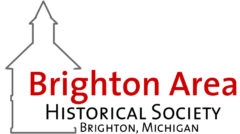Its Springtime, 1907. As one approaches the Village from the north on Grand River and comes to the Village limits (at the corner of Grand River and Cross street), one sees a sign warning: ” Speed Limit 8 Miles per hour”. Continuing one passes over a red, wooded bridge spanning Ore Creek and attention is drawn to the residence of James Fulton; a veteran of the Civil War, having served three years in the 26th Infantry.
For some time, he had been employed as the toll gate keeper for the Detroit- Lansing Plank Road Company. That was before it was moved to the Challis Road corner because travelers had bypassed the toll gate by turning off the Plank Road at Cross Street, coming into town via North Second Street.
Fultons barn stands at the edge of the Creek. It had long been used by businessmen as a billboard to advertise their merchandise. This spring day in 1907, one sees across the upper part of the barn “Come one, Come All to Brightons Home Coming: August 28, 1907. A larger than life size man and his dog, both running at full speed with the man shouting “Iz a Goin to Come Too” had been painted below. The artist? One Dr. “Greencorn”. Not his real name nor a fully licensed veterinary, he displayed some talent as an artist and had successfully treated enough animals especially horses for several farmers to respect his ability. That barn with its message became the areas first billboard.
Continuing into town the road became a low, narrow strip between two swamp ponds for the next three blocks, a sea of mud in wet weather. The ponds and swamps on either side were inhabited by turtles, muskrats and frogs (which were in full croak at this time of year.) All day the red wing black birds (a sure assurance of spring) flew from cattails to cattails singing their accompaniment. One was south of Liberty Street before encountering the next building which was on the east side. Not until one was halfway past the Village Cemetery, readily visible across the swamp on the west, did one pass past another building. After dark the only light available was that of the lightening bugs which wouldnt be out until summer, or the weak glow from a lamp in a window. High land behind the ponds served as pasture for sheep and cattle that contributed to the sounds of Brighton. Stray dogs occasionally disturbed them and soon the farmers shouts could be heard putting a temporary end to their marauding.
Sounds too faint to be heard (Toot and be damned) were responses made by those driving a horse-drawn rig when the driver of an occasional automobile tooted his horn to pass. The shoe was on the other foot when these same horse drivers bought an auto. Then they made sounds intimating horse-drawn rigs should get over to the edge of the road and not be allowed on the road after dark.
The next time you drive Grand Rover north from Main consider the sights and sounds of Brighton.
Condensed and edited from writings of W. A. Pless. Ed. M. Bair
